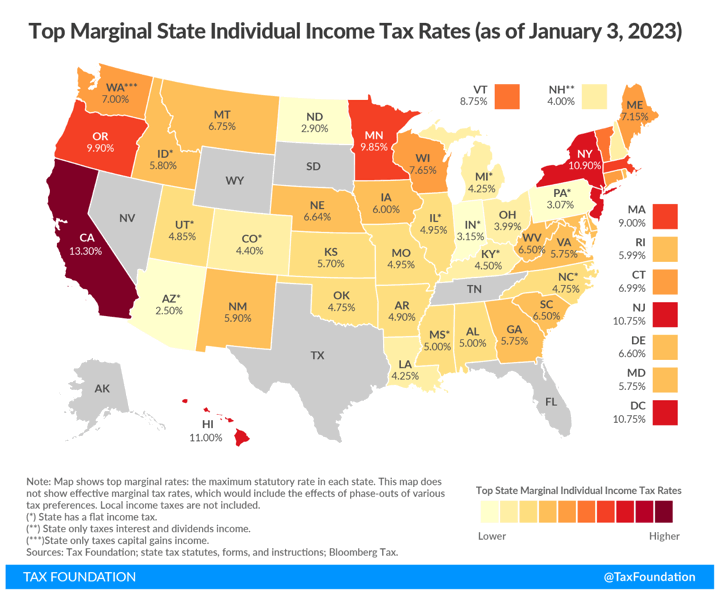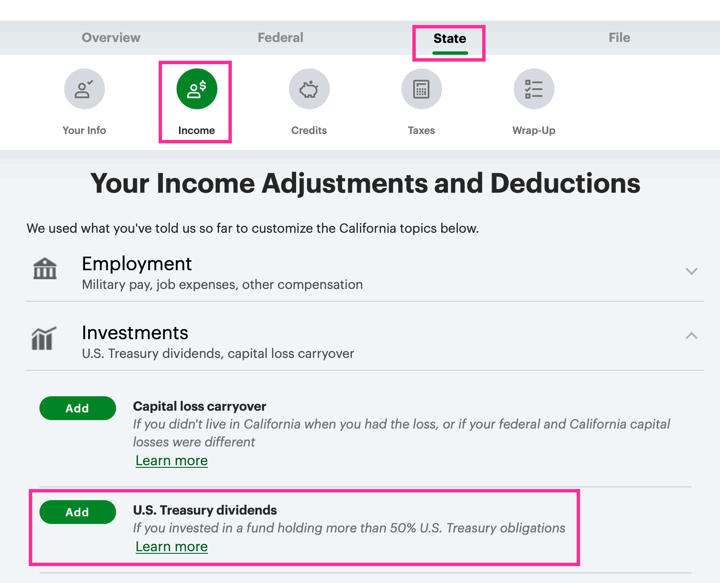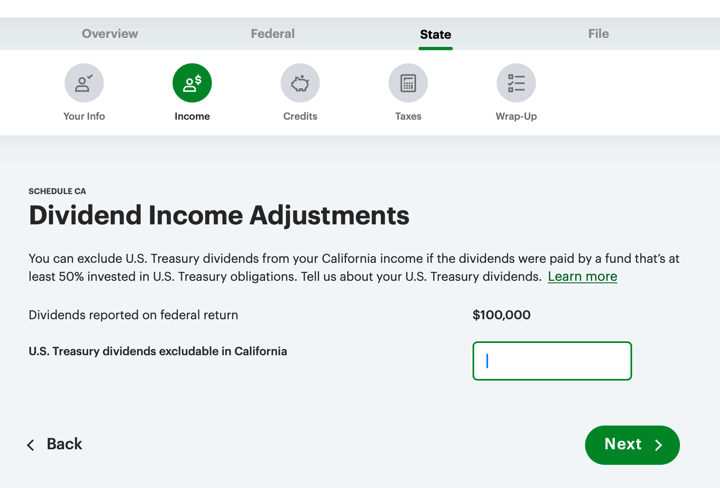
If you earned interest from a money market fund or bond mutual fund/ETF last year, a significant portion of this interest may have come from US Treasury bills and bonds, which are generally exempt from state and local income taxes. (California, Connecticut, and New York have special rules.) However, in order to claim this exemption, you’ll probably have to manually enter it on your tax return after digging up a few extra details.
Here’s how to do it in at HRBlock.com, the online version of H&R Block tax software. I found the two following quotes from the H&R Block FAQ:
How do I enter interest from U.S. Treasury obligations?
This information doesn’t appear on the form, but we’ll need it to calculate the tax-exempt interest on your state return. This information won’t affect your federal return.
Where do I report U.S. Treasury obligations from Form 1099-DIV?
Report them in the Income section on the Interest topic. Enter them as U.S. Savings Bond and Treasury obligation income.
These two answers somewhat conflict with each other, so I just started a new dummy return as a California resident to look around. If you don’t find a box to enter the interest during the 1099-DIV entry process in your Federal return interview (I did not see this), you should be able to enter the information in the State return portion of the interview.
Under the “Income” section of the State Return, there will a screen called “Your Income Adjustments and Deductions”. Here there should be a place to report US Treasury dividends.

Click on “Add” and you will be asked to enter the “US Treasury dividends excludable in [Your State]”. For example, if you received $100,000 in total dividends from the Vanguard Treasury Money Market Fund (VUSXX) in 2023, you will find it does meet the threshold requirements for California, Connecticut, and New York and it had a US government obligation percentage of 80.06% in 2023. In this example, $80,060 of the $100,000 in dividends would be excludable.

Here are some links to find the percentage of ordinary dividends that come from obligations of the U.S. government. You should be able to find this data for any mutual fund or ETF by searching for something like “[fund company] us government obligations 2023”]. If you do not see the fund listed within the fund company, it may be assumed to be 0%.
[Image credit – Tax Foundation]
 The Best Credit Card Bonus Offers – 2025
The Best Credit Card Bonus Offers – 2025 Big List of Free Stocks from Brokerage Apps
Big List of Free Stocks from Brokerage Apps Best Interest Rates on Cash - 2025
Best Interest Rates on Cash - 2025 Free Credit Scores x 3 + Free Credit Monitoring
Free Credit Scores x 3 + Free Credit Monitoring Best No Fee 0% APR Balance Transfer Offers
Best No Fee 0% APR Balance Transfer Offers Little-Known Cellular Data Plans That Can Save Big Money
Little-Known Cellular Data Plans That Can Save Big Money How To Haggle Your Cable or Direct TV Bill
How To Haggle Your Cable or Direct TV Bill Big List of Free Consumer Data Reports (Credit, Rent, Work)
Big List of Free Consumer Data Reports (Credit, Rent, Work)
Great info , thnx.
5 Feb. 2024 , 1605 now, rainy, rainy monday in CAlif.
###
This is not working for me. I am preparing my Oregon return, and it is not letting me subtract Treasury and similar income on my state return if it wasn’t shown on my 1099-INT and 1099-DIV, even though Oregon doesn’t tax it. My first year using HR Block and this is a big disappointment.
For Oregon, in your state return look for a section on adjustment to income and then “Investment interest adjustment
For differences between your federal and Oregon investment interest expense”. You should then be able to enter an adjustment:
Thanks for this! Unfortunately it looks like the only way I can adjust in the state return is to override the entry on the worksheet, which according to the program will prevent efiling. I am using the desktop version. Very frustrating!
I’m not finding a clear way to subtract US Treasury interest in the WI H&R Block interview. There are a number of subtraction categories but not anything that mentions US Treasury interest.
@mark It looks like you can add it as an “other subtraction” , but I agree, I don’t see a place to enter them directly.
Other software like the cash app taxes and freetaxusa have fields for them (freetaxusa you enter in the amount when you enter the 1099-div on the federal side, cash app you enter in the total on the state form).
Hi! Tax Season this year and using H&R Block Web as well and also encountering the missing US Treasury Dividends option that is in your screenshot so that my MMF with % US Govt Obligations (like FDLXX) will be not be completely state-taxed :(.
I clicked on Other Adjustments and Deductions and there is no option for it there either. I wish I can see what you are/were seeing in your screenshot when you posted this article.
Any idea what’s going on now? I feel like the latest version is now the worse version because of this missing feature.
Maybe you can post an updated version of this guide? Thanks in advance and I do appreciate what you shared in this article :)!
Please make sure you are in the State Tax return section, not Federal. Then, under the Income section, there should be an option for adjustments.
The screens may look slightly different for each state, but I checked and California’s in 2024 looks almost exactly the same as last year (2023). Which state are you in?
HI, JONATHAN! U rock and ur blog rocks! Thank u for replying! This is what my MO screen looks like for that section:
https://ibb.co/fz6zG4q7
I thought it would be “Other Adjustments and Deductions”, but it’s not there either:
https://ibb.co/wF2yBCTb
This is so weird! Glad it’s working for you though :)! I spend a lot of time making sure I use MMFs with % USGO so I most definitely wanna deduct that % USGO from state!
Hi Gabe, thanks for the clarification; I started a test state return for Missouri and I do see what you see. I asked their AI agent and they said something about listing it under the 1099-INT as US Treasury interest, but Vanguard lists the interest from their MMFs on their 1099-DIV, so I’m not sure how to input it. I tried entering it in Box 3 under “Nondividend interest”, but that didn’t change the state return numbers for me. I’m not sure if you need to make a manual change somewhere, but I haven’t spent the time to dig further. Sorry I couldn’t be more help right now, I’ll try to circle back later. Let me know if you figure it out on your side.
I have run into the same problem as Gabe. There is no place to enter the portion of dividends that corresponds to government obligations, so they get deducted on my state return from my federally reported income.
I am seeing exactly what he saw under the state and there is no option on the 1099-DIV form of the federal return to enter this amount.
some software, like FreeTaxUSA (and I think TurboTax?) asks for it when you are inputing the 1099-DIV to enter in the amount from government obligations.
Some software, like Cash App taxes, requires you to input it manually on the state section.
HI, ANDY! I ended up just using the Software version of H&R Block and that had exactly what I needed / looking for. Frankly, I am surprised that the web version did not have that field.
I think Software definitely has more features, but I also noticed that at some parts, Web version had more “guidance”, like on filling out Schedule C for a 1099-K. I think I’ll be using Software from this point on, but I still learned some stuff from using the Web version :).
Same issue. How do I take out earnings from US Govt obligations reported in 1099-DIV for filing Iowa taxes.
I encountered this problem using the Online version for Missouri and found no way to enter the info in the State Income section either. I ended up taking the calculated amount out of the Vanguard Dividends and showing it as US Interest on line 3. This got the info subtracted from Missouri AGI.
It turns out that there is a small box “US Treasury interest” in the interview for dividends. This is not checked with auto download. You can then enter a % of your dividends that is exempt. Sadly, if you have multiple funds with different percentages, you have to enter them one at a time. I did a shortcut of computing the total weighted average percentage and entered that instead. After all this work, I still don’t see the deduction in the IA interest worksheet 🙁 At this point, there is no sense in investing more time given the amounts involved. Even so, I am a bit upset with HR Block … is anyone listening at their end?